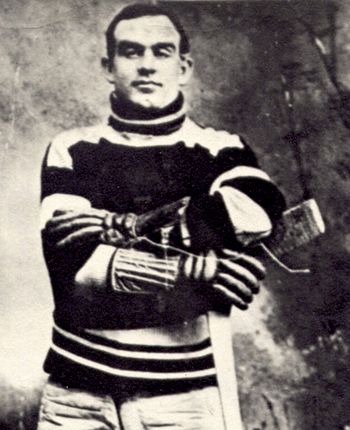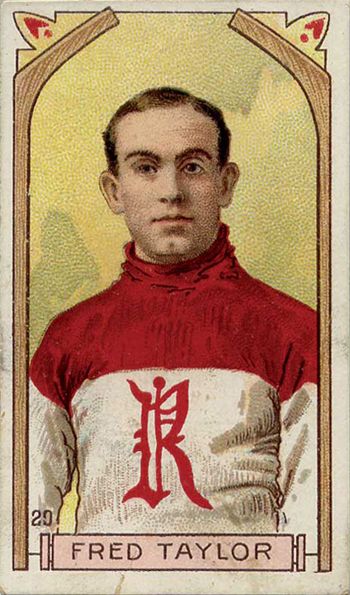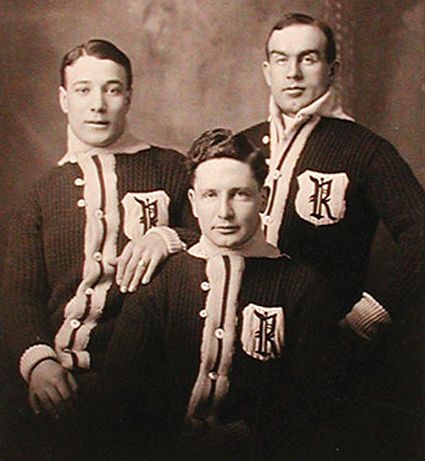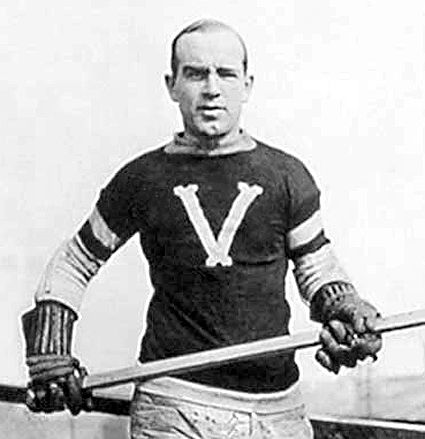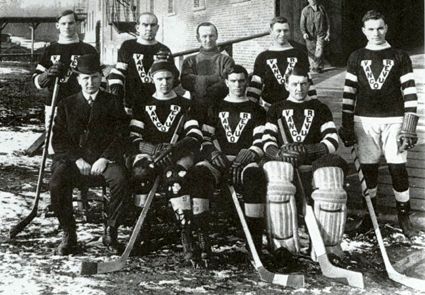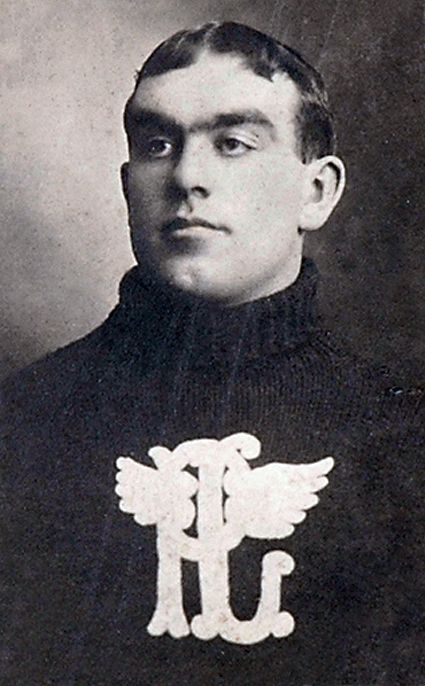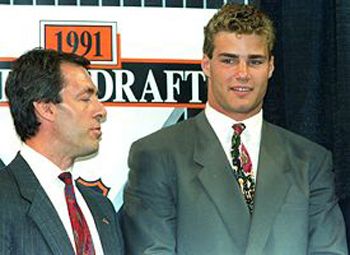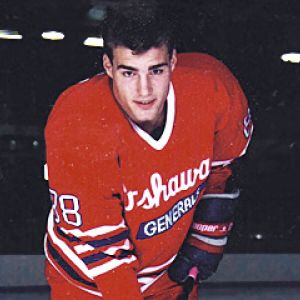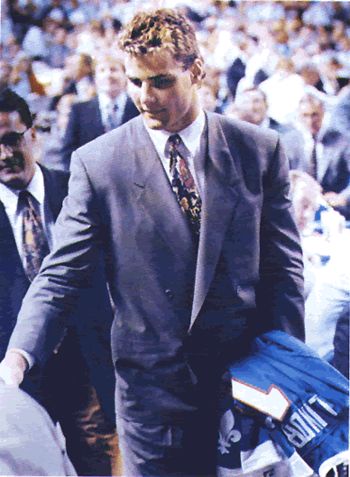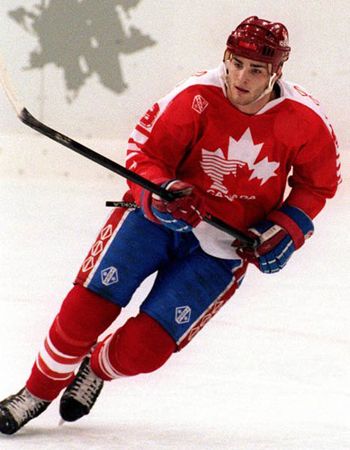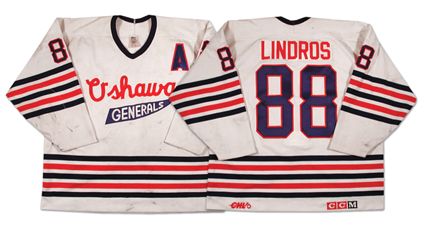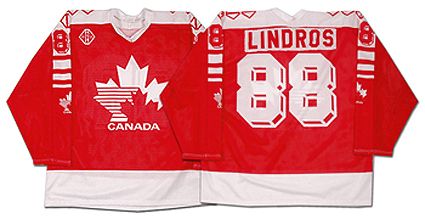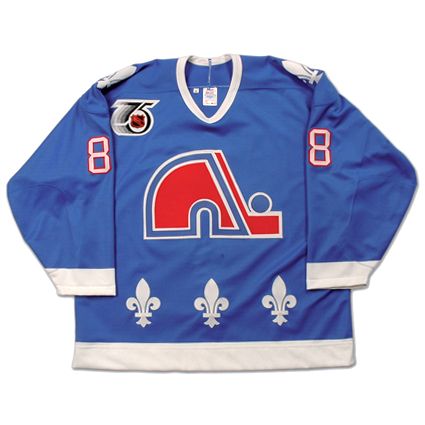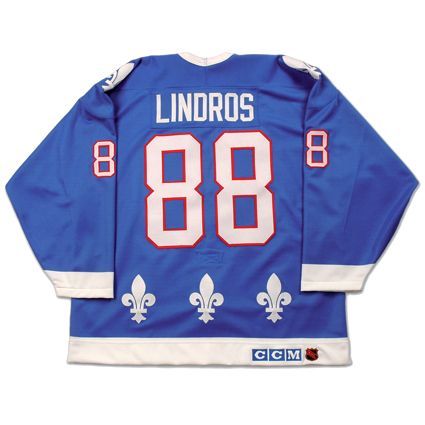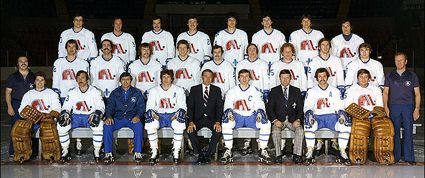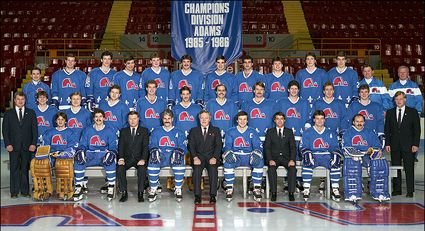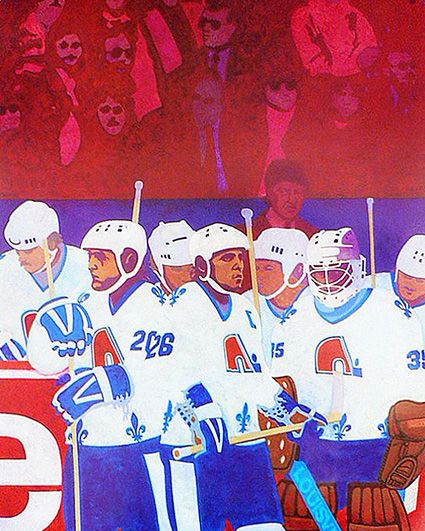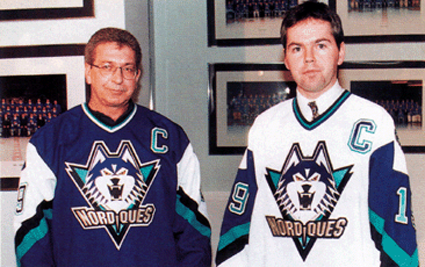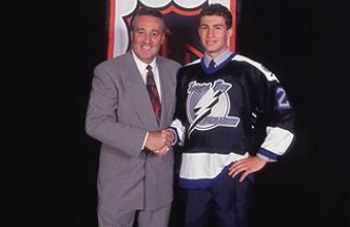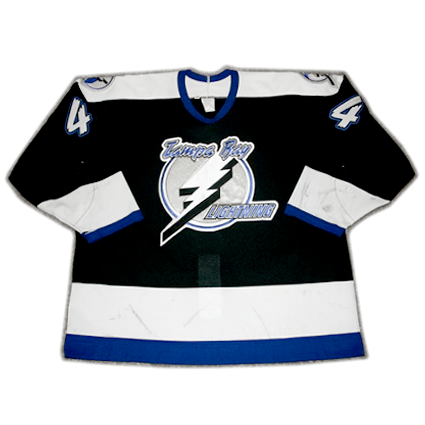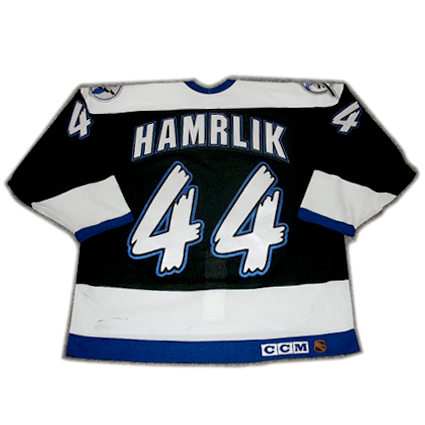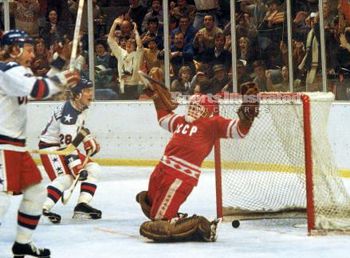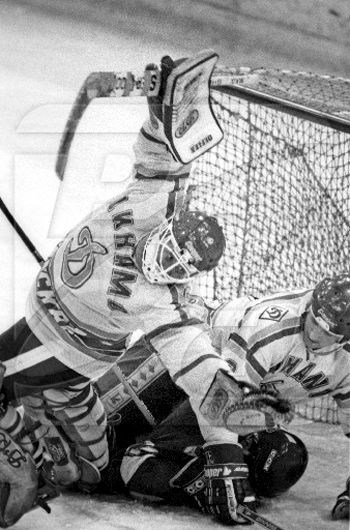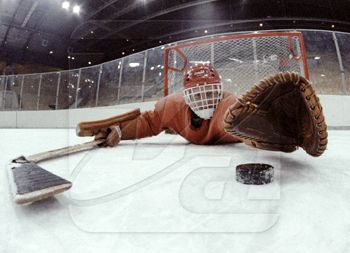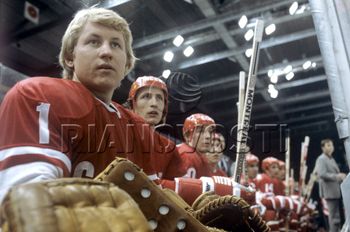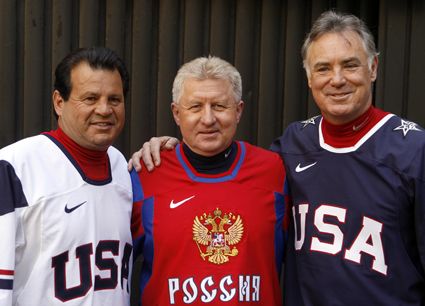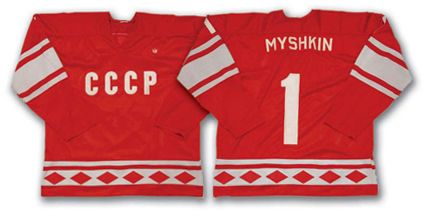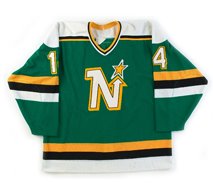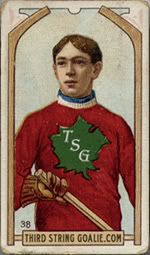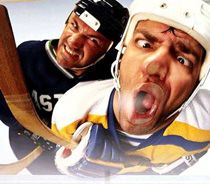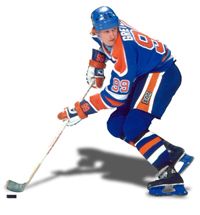Wednesday, June 23, 2010
1905-06 Portage Lake Hockey Club Cyclone Taylor Jersey
Born on this date in 1884, Fred "Cyclone" Taylor was one of the first stars of the fledgling sport of hockey and one of the leading scorers of his day.
As was common in the early days of organized hockey, Taylor played for several teams in several leagues - depending on where the money was. He joined his is first professional club, thanks to a $3,000 salary offer, the Portage Lakes Hockey Club in Houghton, Michigan in the International Professional Hockey League. Taylor arrived in the latter part of the 1905-06 season in time to score 11 goals in 6 games and help the club win the league championship with a 19-5 record.
He returned for the 1906-07 season and scored 14 times in 23 games as Portage Lakes again won the championship, this time with a record of 16-8. With professional teams now starting up in Canada, many of the players preferred to play closer to home and the IPHL disbanded after before the start of the next season.
Taylor moved back east, joining the Ottawa Senators of the Eastern Canada Amateur Hockey Association for the 1907-08 season. In 1908, Taylor played the start of the season with Pittsburgh of the Western Pennsylvania Hockey League but returned to Ottawa in time for the start of the Senators next season. Once back, he scored 9 goals in 11 games as Ottawa won the league title with a 10-2 record. As champions of the league, Ottawa became the holders of the Stanley Cup, previously held by league members the Montreal Wanderers.
Taylor of the Ottawa Senators
It was during this period that Canada's Governor General was so impressed with his incredible speed that he gave Taylor the nickname "Cyclone".
After a falling out with management of Ottawa, Taylor accepted an offer to join the Renfrew Creamery Kings for the inaugural season of the National Hockey Association.
There he was joined by future hall of famers Lester Patrick, his brother Frank Patrick as well as mid-season addition Newsy Lalonde. The paychecks handed out to the Renfew players earned the club the unofficial nickname of the Renfrew "Millionaires". Taylor's salary in particular was the highest ever for a Canadian athlete up to that time and remained so for many years.
Newsy Lalonde, Frank Patrick and Cyclone Taylor of Renfrew
Despite their high priced talent, Renfrew finished third in the league and reportedly lost $17,000 that season. Taylor returned for the 1910-11 season, only without the Patricks or Lalonde.
The club once again finished third in the standings and disbanded following the season, putting Taylor back on the open market. Sort of.
His rights were transferred to the Montreal Wanderers, but Taylor was quoted as saying he'd rather retire than join the Wanderers and ended up playing in a game for the Ottawa Senators. The Wanderers protested Taylor's appearance for Ottawa and won. The game was ordered replayed, Taylor and Ottawa were fined $100 each and Taylor was given an indefinite suspension, ending his 1911-12 season at one game.
In November of 1912, Taylor was lured to the Vancouver Millionaires by his former teammates the Patrick brothers, who had formed the Pacific Coast Hockey League.
Taylor with the Vancouver Millionaires in 1912-13
There, he would find a permanent home, playing the next nine seasons of his career, which included five scoring titles, thanks in part to moving up to forward from defense, a career high of 32 goals in 18 games in 1917-18 and a Stanley Cup championship in 1915 thanks to a 3 games to none win over Taylor's former club, the Ottawa Senators which included Taylor scoring six times in the three games including twice in the cup clinching Game 3. The victory by the Millionaires remains the only Stanley Cup ever won by a team from Vancouver 95 years later.
1915 Stanley Cup champion Vancouver Millionaires
The Millionaires returned to the Stanley Cup Finals in 1918, and while they fell in seven games to the Toronto Arenas, Taylor led all playoff scorers with 9 goals in 7 games.
He stopped playing hockey after the 1920-21 season, but did return for a single game in the 1922-23 season with the club now renamed the Vancouver Maroons. He finished his career averaging more than a goal per game with 194 goals in 186 regular season games.
Following his playing career, he was elected to the Hockey Hall of Fame in 1947. His son Fred Jr. opened a chain of hockey equipment stores called Cyclone Taylor Sports in 1957 which remain in operation today. Since 1967 the playoff champions of the three British Columbia Junior B hockey leagues is awarded the Cyclone Taylor Cup.
In 1979, the Canucks renamed the club's annual MVP award the Cyclone Taylor Award. There are also arenas in Vancouver and his birthplace of Tara, Ontario named in his honor as well as Cyclone Taylor Boulevard, which is one of the four roads around the current Ottawa Senators arena, Scotia Bank Place in Ottawa.
Today's featured jersey is a 1905-06 Portage Lake Hockey Club Fred "Cyclone" Taylor jersey. Or in this case we should we say "sweater". This classic turn of the century hockey sweater features a wonderful "PL" monogram adorned with wings on either side. This heavy sweater certainly would have kept the players warm, as the IPHL played it's games in the winter on natural ice.
While the Portage Lake team only existed for a limited number years, playing exhibition games as early as 1900 and joining the IPHL in 1904 when they began to attract players of note from Canada with the salaries they were paying in the days of amateur hockey, the lineup of future hall of famers was quite impressive, including IPHL founder Jack Gibson in the Builders category, "Bad" Joe Hall, goaltender Riley Hern, team captain Bruce Stuart, his brother Hod Stuart and of course the legendary Cyclone Taylor.
Today's video is a look at the British Columbia Sports Hall of Fame, of which Cyclone Taylor is a member.
Labels:
Portage Lake Hockey Club,
Taylor Cyclone
Tuesday, June 22, 2010
1990-91 Oshawa Generals Eric Lindros Jersey
Despite his steadfast and repeated warnings he would not play for them, the Quebec Nordiques drafted Eric Lindros with the first overall pick in the NHL Entry Draft on this day in 1991.
The Nordiques Pierre Page with Lindros at the 1991 NHL Draft
Lindros, perhaps the most hyped and anticipated player since Wayne Gretzky or perhaps even Bobby Orr, had already led the Oshawa Generals of the OHL to the 1990 Memorial Cup championship with 45 points in 21 playoff games, scored 149 points in 57 games for the Generals to lead the league in scoring in 1991 and was named the league MVP and the CHL Player of the Year.
Lindros with the Oshawa Generals
While Lindros was tearing up Canadian junior hockey, the Quebec Nordiques were the doormats of the NHL, having finished last overall in 1988-89 with 61 points, suffered through a dreadful 1989-90 season scoring a mere 31 points and "improved" to 46 points in 1990-91, earning the right to select first overall for the third consecutive year.
Having already refused to report to the Sault Ste. Marie Greyhounds in junior hockey, Lindros again made his wishes known that he had no intention of playing for the Nordiques due to several factors which did not meet his or his agent's satisfaction, including limited marketing potential, high tax rates in Quebec and the difficulties associated with the exclusively French speaking Quebec City.
With both sides at a standoff, the stubborn Nordiques selected him with the first overall pick anyway. The even more stubborn Lindros wasted no time in snubbing the Nordiques by refusing to wear the club's jersey for photos.
Lindros refusing to wear a Nordiques jersey at the draft
Undaunted, the Nordiques president Marcel Aubut announced that they would build the team around Lindros and refused to trade him, claiming he would not have a career in the NHL as long as he held out. Meanwhile, Lindros played for Team Canada in the 1991 Canada Cup, briefly returned to the Generals for 13 games prior to joining the Canadian National Team for 24 games, participating in the 1992 World Junior Tournament and then the 1992 Winter Olympics, so there was no shortage of places for him to play during his unprecedented standoff with the Nordiques despite their 10-year, $50 million contract offer.
Lindros skating for Canada during his year long holdout
Eventually, after his year long holdout, the Nordiques relented and traded Lindros at the draft in 1992. The problem was, they agreed to trade him on June 20, 1992 to both the New York Rangers and the Philadelphia Flyers in separate deals!
Eventually the NHL arbitrator would rule in favor of the Flyers on June 30th and with that, it was the Flyers who sent a King's Ransom to the Nordiques in the form of Peter Forsberg, Mike Ricci, Ron Hextall, Steve Duchesne, Chris Simon, Kerry Huffman, two first-round draft choices (one of which was used to select Jocelyn Thibault while the other was traded away) plus $15 million!
The trade would send the franchise on the road to the Stanley Cup, which they would win in 1996 as the Colorado Avalanche, their first season after their relocation to Denver, Colorado.
Today's featured jersey is a CCM 1990-91 Oshawa Generals Eric Lindros jersey as worn the season in which Lindros scored 149 points in 57 games just prior to his being drafted first overall by the Quebec Nordiques.
Bonus Jerseys: Today's first bonus jersey is a Tackla 1991-92 Canada National Team Eric Lindros jersey as used in the 1992 Olympics in Albertville, France while Lindros was refusing to play for the Nordiques in Quebec.
This jersey has all the graphics dye-sublimated onto the jersey and features the unusual white nameplate with red letters on a red jersey.
Today's second bonus jersey is a CCM 1991-92 Quebec Nordiques team issued Eric Lindros jersey made for Lindros to wear in his planned rookie season of 1991-92 with the Nordiques, which went unworn as Lindros made good on his threats to not play for the Nordiques and instead embark on a schedule of games with primarily the Canadian National Team until the Nordiques traded him to the Philadelphia Flyers in time for the 1992-93 season.
Today's first video is the Nordiques following through on their promise to take Lindros first overall in the 1991 NHL Entry Draft.
Here is a report on Lindros refusing to play for the Nordiques prior to the draft.
Labels:
Canada,
Lindros Eric,
Oshawa Generals,
Quebec Nordiques
Monday, June 21, 2010
1995-96 Quebec Nordiques Prototype Jersey
On this date in 1995, the NHL gave their approval for the sale of the Quebec Nordiques which resulted in their relocation to Denver, Colorado.
Originally founded in 1972 as one of the original 12 WHA franchises, the Nordiques played seven seasons in the WHA, winning the championship once in 1977.
While the league folded following the 1978-79 season, four of the league's strongest and most stable franchises would enter the NHL as "expansion" franchises, which included the Nordiques.
Life in the NHL proved both exciting and difficult. The Nordiques rivalry with Quebec neighbors the Montreal Canadiens provided some of the most intense battles of the 1980's. After missing the playoffs in 1980, the Nordiques made the playoffs for seven consecutive seasons, including a division title in 1986 and a pair of trips to the conference finals in 1982 and 1985.
Sadly for fans of the Nordiques, the club fell on some very hard times after 1987, missing the playoffs six out of the next seven seasons, including a horrid run from 1988-89 to 1991-92 when the club won a total of 75 games, an average of less than 19 per season, including last place finishes in 1988-89, 1989-90 (33 points behind the second worst team, more than the 31 they actually scored!) and 1990-91.
The Nordiques used the resulting draft picks to select players such as Mats Sundin and Adam Foote (1989), Owen Nolan (1990), Eric Lindros (1991), who they converted into Peter Forsberg, Ron Hextall, Chris Simon, Mike Ricci, Steve Duchesne, Jocelyn Thibault and $15 millon, Adam Deadmarsh (1993). This, in addition to the selection of Joe Sakic (15th overall in 1987), gave the Nordiques a very bright future on the ice, as evidenced by their record-setting turnaround from a 52 point season in 1991-92 to a 104 point season in 1992-93, an improvement of 52 points in one year!
Unfortunately, the future did not look the same off the ice. The weak Canadian dollar hampered the bottom line, as the team's revenues came in Canadian dollars but player salaries were paid in US dollars. No doubt the small size of Quebec City worked against the team and the exclusive use of French in the city both hurt it's ability to attract certain players, sponsorships and contracts with radio and TV outlets. It's home arena, the Colisee de Quebec, bulit in 1949 and it's smaller 15,750 capacity also limited the team's finances.
Nordiques president Marcel Aubut sought financial help from the Quebec provincial government as well as a new publicly funded arena, which was turned down. Eventually the club was sold to Comsat Entertainment Group, already owners of the Denver Nuggets of the NBA, who relocated the team to Denver, Colorado for the 1995-96 season - a year in which they proceeded to immediately win the Stanley Cup with a roster full of players selected to be Nordiques.
Today's featured jersey is a 1995-96 Quebec Nordiques prototype jersey. The original 1972 Nordiques jerseys used light blue had a considerable amount of red on both the shoulders and waist stripe. The following season the blue was changed to a considerably darker shade and the amount of red was limited to the shoulders on the home jerseys and narrower striping.
The familiar Nordiques style was adopted in 1975 and remained in use through the Nordiques final season in Quebec twenty years later, although a new jersey with a modernized logo was unveiled on March 30, 1995 which was originally intended to be worn by the Nordiques in 1995-96, only it's been reported that the club missed the deadline for approval of the jersey in time for the start of the season and the jersey was now scheduled to become the team's new jerseys for the 1996-97 season, only to see the club relocate to Denver, Colorado, where they would be renamed the Avalanche, leaving the now orphaned jerseys to go forever unworn.
The only known photo of the original jerseys shows (not very thrilled) team executives (or perhaps journalists) modeling the sweaters, failing to show even the full length of the jerseys to reveal the intended waist striping.
None of these jerseys were ever mass produced for retail sale, although some attempts to create them have been made, but none in any great quantities and some less accurate than others.
We've tried to research these jerseys as best we can, but if you have any more details, corrections or additions to our research, feel free to let us know at
Our video section today begins with the 1984 playoffs "Good Friday Brawl"
between the Nordiques and Canadiens.
Here is a report on Eric Lindros refusal to play for the Nordiques, a stance
which would eventually lead to the long-term success of the franchise - after it moved to Denver.
Finally, two more videos showing how the team was playing well, but
financially the club was a state of financial decline.
Sunday, June 20, 2010
1995-96 Tampa Bay Lightning Roman Hamrlik Jersey
The 1992 NHL Entry Draft was held on this date in Montreal and the Tampa Bay Lightning selected defenseman Roman Hamrlik of Czechoslovakia with the first overall pick, the first Czech ever drafted #1 overall.
Hamrlik with Phil Esposito after being drafted #1 overall in 1992. So why is the #1 pick given a jersey with the #2?
The Ottawa Senators followed with center Alexi Yashin at #2, Mike Rathje went third to the San Jose Sharks, left wing Todd Warriner fourth to the Quebec Nordiques and the New York Islanders rounded out the top five with the rugged Darius Kasparitis, making three defensemen among the top five.
Other notable selections in the first round were Cory Stillman at #6 to the Calgary Flames, Sergei Gonchar went 14th to the Washington Capitals and long-time NHLers Martin Straka 19th to the Pittsburgh Penguins and Grant Marshall 23rd to the Toronto Maple Leafs.
Later round successes were Michael Peca at #40 to Vancouver, Darren McCarty #46 to Detroit, #65 Kirk Maltby to Edmonton, #88 Jere Lehtinen to the Minnesota North Stars, Adrian Aucoin #117 to Vancouver, the indestructable Ian Laperriere to St. Louis at #158, Stephane Yelle at #186 in round 8 to New Jersey and future NHL All-Stars Nikolai Khabibulin #204 in Round 9 to Winnipeg and in Round 10, Anson Carter, #220, to Quebec.
The latest pick to see NHL action was Andrei Vasilyev (#248) who played 16 games over four seasons with the Islanders (15) and the Phoenix Coyotes (1).
Hiroyuki Miura became the first Japanese player drafted at #260 in the 11th and final round, if you don't count the fictitious Taro Tsujimoto taken in 1974 by Punch Imlach of the Buffalo Sabres! Miura played six games with the Wheeling Thunderbirds of the ECHL in 1993-94, but never came close to playing in the NHL.
Hamrlik made his NHL debut later in 1992 with the Lightning and played in 67 games and scored 21 points. He maintained his scoring pace the next season, but raised his toughness level, nearly doubling his penalty minutes from 71 to 135. Three more seasons in Tampa followed, including a career high 16 goals and 65 points in 1995-96, until Hamrlik was traded to the Edmonton Oilers halfway through the 1997-98 season as part of a five player trade.
Two and a half seasons in Edmonton were followed by a trade to the New York Islanders, where he played for four full seasons. He spent the lockout season of 2004-05 like many other European NHLers by returning to the final club he played for prior to moving to North America, in Hamrlik's case, ZPS in Ziln of the Czech Republic.
With the lockout concluded, Hamrlik signed with the Calgary Flames as a free agent for two seasons prior to choosing the Montreal Canadiens as his next home beginning in 2007-08.
A major reason for Hamrlik's lengthy NHL career has been his remarkable consistency. Since 1994, Hamrlik has scored between 21 and 46 points, save for the one season he hit 65. He has also missed a minimum of games, with 13 of the last 14 seasons playing 70 games or more.
Internationally, his opportunities have been somewhat limited by his regular appearances in the NHL playoffs, but Hamrlik as competed for the Czech Republic in the 1994 World Championships, the 1996 World Cup, the 1998 Olympics where he won a gold medal, the 2002 Olympics, the 2004 World Championship and the 2004 World Cup.
Thanks to his longevity he has currently surpassed 1200 games played and is approaching 600 points and 150 goals, currently sitting at 590 points at 148 goals.
Today's featured jersey is a CCM 1995-96 Tampa Bay Lightning Roman Hamrlik jersey as worn during his highest scoring season when he scored a career high 16 goals and 65 points. He also made his first appearance in the NHL playoffs that season.
This style Lightning jersey was originally worn in their debut season of 1992-93 with a silver numbers and a blue drop shadow and a unique font for the names on the back. The following season the fonts were italicized, making for the best looking Lightning jerseys in their history.
For some reason, the club changed to radially arched letters and the now white paintbrush font numbers, which have little to do with the name "Lighting", after only just one season. This style remained in use through the 1999-2000 until they changed to a much more boring block style font and one color names with no arching or any other feature to make them unique, as all other Lightning fonts had been throughout their history up until this point. It's a change we've never understood, considering their past history of unusual choices.
Today's video section begins with Roman Hamrlik being selected first by a Third String Goalie favorite, Phil Esposito.
Next, Hamrlik converts the world's best saucer pass by Tomas Plekanec after Plekanec skates the length of the ice through the entire Islanders team to win the game in overtime.
Finally, highlights of Hamrlik's time with both Calgary and Montreal, set to the typical YouTube soundtrack. No penalty points for turning your speakers off.
Labels:
Hamrlik Roman,
Tampa Bay Lightning
Saturday, June 19, 2010
1981 Soviet Union National Team Vladimir Myshkin Jersey
Born on this date in 1955, Vladimir Myshkin is best remembered for being the goaltender who gave up Mike Eruzione's game winning goal in the 1980 Olympic "Miracle on Ice" game versus the United States, but there was certainly more to the man that just that single goal against.
Myshkin reacts to Eruzione's goal in 1980
He began his career with Krylia Sovetov (Soviet Wings), the club sponsored by the Soviet Air Force, where he played in both the 1977-78 and 1978-79 seasons. Following the 1979 season, he made his World Championship debut with the Soviet Union in 1979, playing in two games on the gold medal winning team.
For the 1979-80 season, Myshkin would move to the KGB's Dynamo Moscow club, where he would remain for the next 11 seasons as their undisputed number one, averaging nearly 40 games a season in a league with a schedule of between 40 and 50 games a year.
Myshkin in goal for Dynamo
Unfortunately for Myshkin, his career at Dynamo coincided with the rival Red Army (also known as CSKA Moscow) club's most dominant period in their history, reeling off 13 consecutive Soviet League titles from 1977 to 1989. Finally, in Myshkin's final season with the club, payoff arrived as Dynamo Moscow was finally able to wrest the title away from Red Army in 1990.
Following the long sought after Soviet League championship, Myshkin would play one final professional season with Lukko Rauma in Finland's SM-Liiga as their number one goalie.
Internationally, Myshkin was a regular member of the Soviet National Team, but like his timing playing for Dynamo during the era of Red Army, Myshkin's career as a goaltender unfortunately coincided with that of the legendary Vladislav Tretiak, recognized world-wide as one of, if not the, top goaltender in the world. The result for Myshkin was a trophy case full of medals and little playing time.
He was a member of the gold medal winning World Championship team in 1979 (2 games played), 1981 (1), 1982 (3) and 1983 (3). Finally after the retirement of Tretiak in 1984, Myshkin was given the reins in 1985 and played in ten games only to see the Soviet Union knocked off their perch and finish third after losing to both Czechoslovakia and Canada in the Final Round.
And with that, Myshkin once more returned to his familiar role as backup on the National Team, as in the 1989, 1990 and 1991 World Championships, he would play but one game in each tournament, yet come home with gold medals in both 1989 and 1990.
The story was very much the same in the 1981 Canada Cup with one start in seven games but another gold medal to bring home in his luggage.
Myshkin at the 1982 Izvestia Cup
Thing would change in the 1984 edition of the Canada Cup with Tretiak now out of the picture following his retirement after winning a gold medal at the 1984 Olympics, where Myshkin saw action in but a single game once more.
Despite Myshkin's failure to secure the nearly customary gold medal in the 1984 World Championships, he was back in goal at the 1984 Canada Cup. While Myshkin would defeat Czechoslovakia, Sweden and the United States in round robin play, he would once again fall short with the weight of the world on his shoulders as Canada would take the Soviets to overtime in their semifinal match, the first overtime game in Soviet National Team history, only to have Mike Bossy deflect a puck past Myshkin, who was without his stick after Bossy had collided with him several seconds earlier, to eliminate the Soviets from the competition but Myshkin was named the goaltender on the tournament All-Star Team.
Perhaps the highlight of Myshkin's international career was his 6-0 shutout of the NHL All-Stars at the 1979 Challenge Cup, after the Soviets, with Tretiak in goal, had split Games 1 and 2.
All told, Myshkin would collect six World Championship gold medals, a gold in the Canada Cup and an Olympic gold medal, eight golds in all, and play in a total of just 13 games, perhaps the greatest return on investment in the history of hockey!
Myshkin in his all too familiar spot on the end of the national team bench
Following his playing career, Myshkin would coach the Swiss club HC Davos from 1994 to 1999 and later become the goaltending coach of Dynamo and CSKA Moscow before coaching Vityaz Chekov in Russia.
1980 Olympians Mike Eruzione, Vladimir Myshkin and Jim Craig at a promotional appearance in advance of the 2010 Olympics
Today's featured jersey is a 1981 Soviet National Team Vladimir Myshkin jersey as used in the 1981 Canada Cup tournament.
This style of Soviet jersey with the diamond shapes around the waist was used from the 1976 Canada Cup until 1983, which included the memorable 1980 Olympics.
Our first video today is the game winning goal from the "Miracle on Ice" when Mike Eruzione of the United States gets one past Myshkin in the Soviet goal in place of Tretiak in the third period of their game for the ages.
Here is Canada defeating the Soviet Union in overtime of the 1984 Canada Cup semifinals.
We conclude today with Myshkin's finest game, the third game of the 1979 Challenge Cup, when Myshkin and the Soviets shut out the NHL All-Stars 6-0.
Labels:
Myshkin Vladimir,
Soviet Union
Subscribe to:
Posts (Atom)

